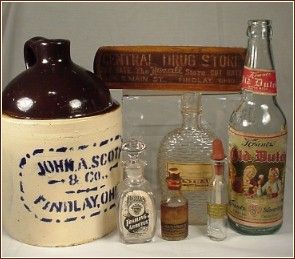Contributing writer Joe Clevenger gives us his latest article on Cincinnati, Ohio's Frank Tea & Spice Co.'s JUMBO PEANUT BUTTER.
(If the scrolling pdf viewer box doesn't load, click to read it here.)
Thanks, Joe!
The Frank Tea and Spice Company made DOVE BRAND spices and products as well as JUMBO Peanut Butter.
_________________________
As we posted before (back at the 2010 Muncie show, video here), the green glass figural elephant Jumbo Peanut Butter bank jars have been reproduced.
A real one sold for $575 on the North American Glass (NAG) auction site's Jumbo jar collection auction. (Link)
This photo shows a side-by-side comparison.
_____________________________
There is even a Frank/Bitters connection. Read about the Prairie and Plantation Bitters figural cabin bitters bottle here on Peachridge Glass.
______________________________
Speaking of elephants and doves...
That was how the artist Frieda Kahlo's parents referred to petite Frieda and her large husband, Diego Rivera. [Source]
_________________________
Here's a little history on the real JUMBO the Elephant:
" Jumbo (ca. Christmas 1860 – September 15, 1885) was the first international animal superstar, and the first African elephant to reach modern Europe alive.[1] He was born inEast Africa, and captured there by Arabian hunters in early 1862. He was sold first to an Italian animal dealer, then to a menagerie in Germany, and then to the Jardin des Plantes inParis. Officials of the Jardin traded him to the London Zoological Gardens for a rhinoceros. Jumbo lived in the London Zoo for about 16 years, where he delighted visitors by taking them on trips around the zoo grounds in thehowdah on his back.
Above excerpt is from Wikipedia. Read much more about Jumbo there: https://en.wikipedia.org/wiki/Jumbo
_______________________________________________
Findlay Antique Bottle Club
Website - Facebook - Twitter
Sign up for our free newsletter!




















No comments:
Post a Comment
Please leave us a comment - we love to hear what you have to say!